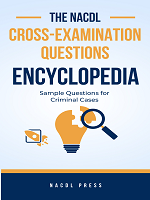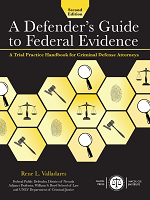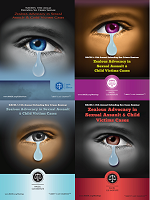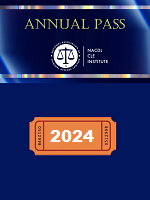Access to The Champion archive is one of many exclusive member benefits. It’s normally restricted to just NACDL members. However, this content, and others like it, is available to everyone in order to educate the public on why criminal justice reform is a necessity.
Menacing Male Voice: I was convicted of sexual assaulting three different children.
Second Menacing Male Voice: I was convicted of shooting my ex-girlfriend in the face and murdering her sister while our daughter watched.
Third Menacing Male Voice: I was convicted of sexually assaulting a woman and her 10-year-old daughter, and then I slashed their throats and burned them.
Defiant Male Voice: On appeal, Justice Thomas Kilbride sided with us over law enforcement and our victims.
Disappointed Male Voice: Unfortunately for felons like us, other judges overruled Kilbride and our convictions stood.
Alarmed Female Voice: Thomas Kilbride sided with violent felons like these and in dozens of other cases that you can find at “Kilbride Protects Felons.Org.” Vote NO on retention of Supreme Court Justice Thomas Kilbride.
This dialogue is not fiction. It is an example of the slew of attack ads in the recent judicial election season — one that is likely to smash all records for expenditures in judicial elections. What is particularly disturbing about this attack on incumbent Illinois Supreme Court Justice Thomas Kilbride is that it opens a new front in the attack on judicial candidates. Justice Kilbride was on the ballot in a retention election — a nonpartisan procedure designed to insulate judicial incumbents from the money wars inherent in partisan electoral politics. Not anymore. This year, interest groups awash in cash targeted incumbent judicial candidates in retention elections.1
In the rush to promote their agenda, interest groups have a history of attacking judges not on the issues that are most important to the groups, but rather on the issues on which virtually all judges are vulnerable: their criminal justice decisions. There is a long tradition of stoking public fears about violent crime to discredit judicial candidates. Last term’s U.S. Supreme Court decision in the Citizens United case,2 which ended bans on election spending by corporations and unions, has now opened the floodgates. Third-party groups can spend at will. And just how much money will be pumped into these judicial elections? Plenty.
A joint report recently published by the Justice at Stake Campaign, the Brennan Center for Justice, and National Institute of Money in State Politics documents that campaign fundraising more than doubled in the past 10 years, from $83.3 million in 1990-1999 to $206.9 million in 2000-2009.3 Well-heeled special interest groups clearly dominate the process, with the top five spenders in the 10 most costly judicial elections investing an average of $473,000, while the remaining 116,000 contributors averaged $850 each. Worse, much of this money is going into broadcast attack ads, just like the one excerpted above. Reports out of Illinois indicate that more than $3 million flowed into the Kilbride retention race.
The prospect of special interest money overwhelming the judicial election process prompted President Jim Lavine to identify the protection of judicial independence as a high priority for NACDL. In his inaugural remarks, Jim observed that “when a judge is attacked in the increasingly cash-influenced election process, the organized bar has a responsibility to defend the independence of the judiciary.” To that end, Jim has created a Task Force on Judicial Independence.4 The task force will develop NACDL policy on judicial selection procedures and guide NACDL’s efforts to safeguard judicial independence whenever the judiciary is unfairly attacked. This initiative is long overdue for the nation’s criminal defense bar.
Although big money is most often employed in the struggle between business and conservative groups on one side and the plaintiffs’ bar and union interests on the other, the road kill in this obscene effort to buy justice is the criminal justice system.5 Ads like the attack on Justice Kilbride proliferate. Even though Justice Kilbride’s opponents reportedly sought to defeat him in this retention election as a result of a decision in a case that removed a malpractice cap, the spinmeisters knew that it would be far easier to turn the public against a justice by playing the fear card.6 And so, without any consideration of the merits of the cases or any analysis of the fundamental constitutional issues at stake, the public was subjected to the caricature of a justice purportedly in cahoots with three violent predators. For anyone who doubts the enormity of this program, here’s the kicker:
Assertive Male Voice: Justice Tom Kilbride — a strong advocate for the victims of crime — endorsed by our police and prosecutors. Tom Kilbride wrote the opinion that protected victims of sex crimes from their attackers and issued rulings to simplify the prosecution of sexual predators and domestic violence abusers. We need judges who stand up for victims — not criminals. For Fairness. For Victims. For Justice. Vote YES for Tom Kilbride.
That’s right. To save his judicial seat, Justice Kilbride did not respond to the hysterical and unseemly attack with a defense of his application of fundamental legal principles in his decision-making. He did not explain that when a judge reverses an improperly obtained conviction it is not because he “sides with felons.” Instead, he responded by pledging to be an advocate for victims and stressing his affinity for police and prosecutors.
One has to shudder at the prospects for justice in a system in which the guarantors of our liberty must pander to fear in order to survive. Are we now on the road to a system in which legal scholarship, good judgment, and impartiality render a judicial candidate unelectable? Will fair and independent judges soon be obsolete? Unless society, led by the organized bar, awakens to this ominous danger, this may be our fate. In fact, that’s exactly what Justice Tom Kilbride thinks. Even as he responded to the attacks by raising his own war chest to finance a vigorous counter-assault, he observed, “If we are going to allow the courts to be politicized to this degree, where there’s more and more big-time money coming in, it’s going to ruin the court system and we might as well shut down the third branch.”7
On Nov. 2, 2010, Judge Kilbride’s detractors did not succeed in removing him from the Illinois Supreme Court. Unofficial results indicate that he barely garnered 65 percent of the vote, just five percentage points more than needed to retain his seat on the bench.8
Notes
- Attacks on judges appearing on 2010 retention ballots took place in Iowa, Kansas, Colorado, as well as Illinois.
- Citizens United v. Federal Election Commission, 130 S. Ct. 876 (2010).
- JAMES SAMPLE, HOFSTRA UNIVERSITY SCHOOL OF LAW, ADAM SKAGGS AND JONATHAN BLITZER, BRENNAN CENTER FOR JUSTICE AT NYU SCHOOL OF LAW & LINDA CASEY, NATIONAL INSTITUTE OF MONEY IN STATE POLITICS, THE NEW POLITICS OF JUDICIAL ELECTIONS 2000-2009: DECADE OF CHANGE 1-3, 10-11 (2010).
- Members of the task force include Jim E. Lavine, Richard Jaffe, Elizabeth Kelley, and Andrea Lyon. NACDL staff members supporting the task force are Executive Director Norman L. Reimer, Counsel for Special Projects Malia Brink, and Education Assistant Patrick Veasy.
- In Caperton v. Massey, 129 S. Ct. 2252 (2009), the Supreme Court ruled that due process requires the recusal of an elected judge when it might appear that the judge has a bias toward a party who was a major campaign contributor. In an amicus brief arguing for the need to have a broad recusal requirement, NACDL discussed the tendency for campaigns to devolve into attacks focusing on a judge’s criminal justice decisions. The brief cites a litany of cases in which judicial candidates attacked opponents as “soft on crime,” or pledged to be “tough on crime,” clearly placing the appearance of impartiality at risk. See NACDL’s Jan. 5, 2009, amicus brief in Caperton, available at http://www.nacdl.org/public.nsf/newsissues/amicus_attachments/$FILE/Caperton_amicus.pdf.
- NACDL takes no position in any judicial race and does not imply any support or opposition on the merits of Justice Kilbride’s candidacy.
- Carrie Johnson, No Opponent, but Big Money in the Race, NPR, Oct. 26, 2010.
- Robert Themer, Election 2010: Kilbride Wins Retention Despite Being Targeted, available at http://www.daily-journal.com/archives/dj/display.php?id=463704; Monique Garcia, State Supreme Court Justice Wins Retention Battle, available at http://www.chicagotribune.com/news/local/ct-elect-kilbride-20101102,0,5755646.story; Steve Stout, Kilbride Survives Anti-Retention Effort, available at http://mywebtimes.com/archives/ottawa/display.php?id=41708.






